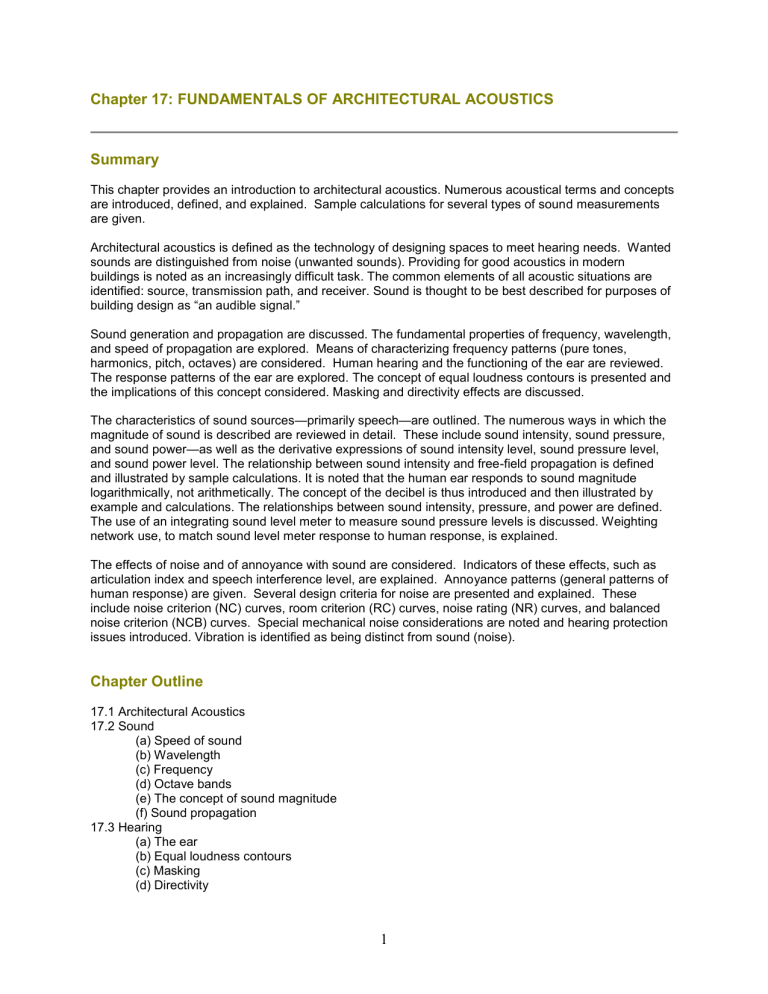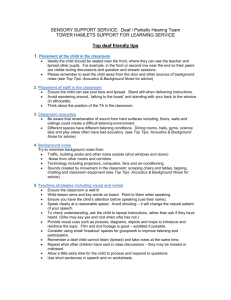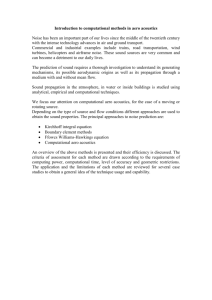ch17

Chapter 17: FUNDAMENTALS OF ARCHITECTURAL ACOUSTICS
Summary
This chapter provides an introduction to architectural acoustics. Numerous acoustical terms and concepts are introduced, defined, and explained. Sample calculations for several types of sound measurements are given.
Architectural acoustics is defined as the technology of designing spaces to meet hearing needs. Wanted sounds are distinguished from noise (unwanted sounds). Providing for good acoustics in modern buildings is noted as an increasingly difficult task. The common elements of all acoustic situations are identified: source, transmission path, and receiver. Sound is thought to be best described for purposes of building design as “an audible signal.”
Sound generation and propagation are discussed. The fundamental properties of frequency, wavelength, and speed of propagation are explored. Means of characterizing frequency patterns (pure tones, harmonics, pitch, octaves) are considered. Human hearing and the functioning of the ear are reviewed.
The response patterns of the ear are explored. The concept of equal loudness contours is presented and the implications of this concept considered. Masking and directivity effects are discussed.
The characteristics of sound sources —primarily speech—are outlined. The numerous ways in which the magnitude of sound is described are reviewed in detail. These include sound intensity, sound pressure, and sound power —as well as the derivative expressions of sound intensity level, sound pressure level, and sound power level. The relationship between sound intensity and free-field propagation is defined and illustrated by sample calculations. It is noted that the human ear responds to sound magnitude logarithmically, not arithmetically. The concept of the decibel is thus introduced and then illustrated by example and calculations. The relationships between sound intensity, pressure, and power are defined.
The use of an integrating sound level meter to measure sound pressure levels is discussed. Weighting network use, to match sound level meter response to human response, is explained.
The effects of noise and of annoyance with sound are considered. Indicators of these effects, such as articulation index and speech interference level, are explained. Annoyance patterns (general patterns of human response) are given. Several design criteria for noise are presented and explained. These include noise criterion (NC) curves, room criterion (RC) curves, noise rating (NR) curves, and balanced noise criterion (NCB) curves. Special mechanical noise considerations are noted and hearing protection issues introduced. Vibration is identified as being distinct from sound (noise).
Chapter Outline
17.1 Architectural Acoustics
17.2 Sound
(a) Speed of sound
(b) Wavelength
(c) Frequency
(d) Octave bands
(e) The concept of sound magnitude
(f) Sound propagation
17.3 Hearing
(a) The ear
(b) Equal loudness contours
(c) Masking
(d) Directivity
1
(e) Discrimination
17.4 Sound Sources
(a) Speech
(b) Other sounds
17.5 Expressing Sound Magnitude
(a) Sound power
(b) Sound pressure
(c) Sound intensity
(d) The decibel
(e) Sound power level
(f) Sound pressure level
(g) Measuring sound
17.6 Noise
(a) Annoyance
(b) Noise criteria
(c) Noise criteria curves
(d) Room criteria curves
(e) High noise levels and hearing protection
17.7 Vibration
References
Key Concepts
architectural acoustics (as an important area of design) difficulty of providing good acoustics (as a reminder to properly consider this aspect of design) common elements of all acoustic systems (as a useful organizational structure) frequency (as a fundamental property of sound) speed of sound (as slower than light, critical to consider, and variable with material) descriptions of sound magnitude (as involving numerous measures and units) free-field sound propagation (as a design situation) basics of human hearing (as the foundation for architectural acoustics) equal loudness contours (as fundamental to understanding human response to sound) masking (as a design tool or as a problem) logarithmic response of human ear (explaining qualitative evaluations of sound) decibel scale (used universally to quantify sound magnitude) meaning of the term “level” (to signify a ratio, expressed as a decibel value) weighting (of sound measurement devices; available options) noise and annoyance (as undesirable acoustic situations) noise or room criterion curves (as a typical means of expressing design criteria) hearing protection versus comfort (as a design objective in some spaces) vibration (felt by occupants versus being heard)
Terminology and Metrics
Important Terminology
Occupational Safety and Health Administration (OSHA) architectural acoustics sound source transmission path receiver
2
longitudinal wave motion wavelength frequency (pitch) fundamental frequency harmonic (overtone) pure tone octave center frequency octave band half-octave band third-octave band magnitude of sound loudness sound power sound power level sound pressure sound pressure level sound intensity sound intensity level decibel scale (decibel) free-field propagation inverse square law point source spherical waves line source plane waves human ear outer ear auditory canal middle ear hammer, anvil, stirrup eardrum (tympanic membrane) inner ear cochlea auditory nerve threshold of hearing presbycusis logarithmic response equal loudness level contours (Fletcher-Munson contours) weighting (of measurement devices) weighting network
A, B, C weighting designations integrating sound level meter phoneme masking pink noise noise annoyance equipment sound (noise) quality neutral hiss rumble vibration impulse noise vibration
3
Important Metrics
Hz (Hertz; the “old” cycles per second) fps (feet per second)
Å (Angstrom)
Pa (Pascal) bar (also μ bar)
P (sound power, watts)
PWL (sound power level, decibels) p (sound pressure, Pascals)
SPL (sound pressure level, decibels)
I (sound intensity, watts per square centimeter)
IL (sound intensity level, decibels) phon (loudness; “self-dimensioned” contours) dB (decibel; 10 times the log to the base 10 of a given ratio)
NC (noise criterion curve; expressed in decibels)
NCB (balanced noise criterion curve; expressed in decibels)
RC (room criterion curve; expressed in decibels)
NR (noise rating curve; expressed in decibels)
AI (articulation index; integer values representing percentages)
SIL (speech interference level; dB)
TWA (time weighted average)
A, B, C (weighting scale identifiers)
Links to Resources
Acoustics FAQ (frequently asked questions; dense pages, but some interesting information): http://www.faqs.org/faqs/physics-faq/acoustics/
Noise Pollution Clearinghouse: http://www.nonoise.org/
Classroom acoustics WWW site: http://www.classroomacoustics.com/
Occupational Safety and Health Administration (noise and hearing conservation): http://www.osha-slc.gov/SLTC/noisehearingconservation/index.html
4







